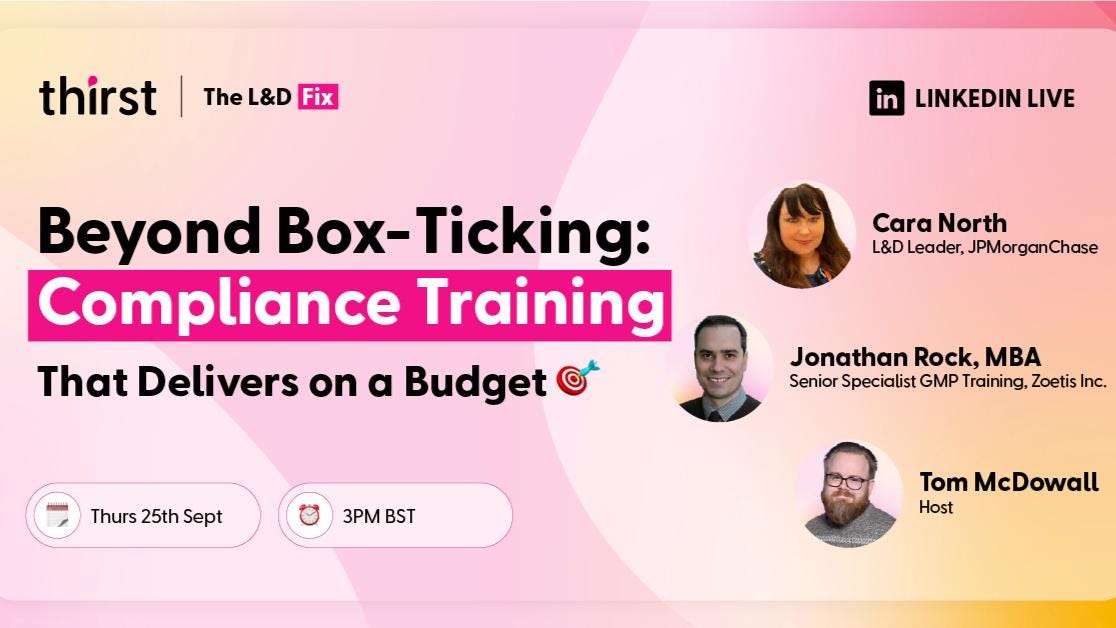Click, Click, Test...
Rethinking Compliance Training Delivery
Every compliance training request seems to follow the same predictable trajectory. The brief arrives with “regulatory requirement” stamped across the top, and before anyone’s had time to think properly, we’re sketching out slide sequences and quiz questions. Thirty slides, five interactions, one assessment, and apparently, we’ve built competence. It’s a comforting fiction, but fiction nonetheless.
The assumption that compliance equals e-learning has become so embedded that we rarely pause to think more deeply about how we could deliver value. Instead, we build digital monuments to our own diligence, complete with certificates that prove someone clicked through our carefully constructed obstacle course.
But compliance isn’t about completion rates. It’s about supporting people to perform their roles correctly when it matters most, keeping them safe, and ensuring that no one gets in trouble with the law.
When Simple Solutions Work Best
I once worked with a natural gas transfer station where staff dutifully completed annual e-learning modules about gas safety procedures. Thirty minutes of content, five questions at the end, and everyone passed. This all sounds great, nice and compliant. Except, of course, that this was a company-wide training, pretty much designed for Gas Network engineers. The problem being, the area of the business I was working with dealt with company administration.
What they needed wasn’t comprehensive knowledge about gas composition or pressure systems. They needed to recognise the smell of gas and know exactly what to do next. So we replaced the e-learning with a simple laminated card that fit in their pocket. It described what gas smells like (they could smell a sample during their induction, so this is just a reminder) and listed three sequential steps: who to call, what information to provide, and when to evacuate.
The card cost pennies to produce and took thirty seconds to reference. It also worked precisely when and where it was needed, without requiring anyone to remember details from a training session they’d completed months earlier.
To meet a regulatory requirement, everyone was then simply asked to complete an annual confirmation that they had the card, knew what gas smelled like, and considered themselves to be sufficiently trained to execute their roles and responsibilities in the event of a gas leak.
No Slides, no Interactions, no SCORM file, no games, and a ridiculous amount of time, money, and goodwill saved.
Practical Formats
Job aids like that gas card represent just one alternative in a toolkit that many teams overlook entirely. When someone needs to understand data protection responsibilities for handling client information, a one-page PDF guide that sits beside their computer often serves better than an interactive module they’ll complete once and forget.
These guides work because they provide just-in-time support at the moment of need. They don’t test knowledge; they provide it. They don’t measure engagement; they enable performance.
Email-based learning sequences can be surprisingly effective for compliance topics that need reinforcement over time. Rather than front-loading everything into one comprehensive session, periodic emails can introduce concepts gradually and link them to specific workplace situations. A monthly email about information security that highlights one common scenario and shows how policy applies gets read and discussed in ways that annual mandatory training rarely achieves.
Note: This same sequencing principle can be used with WhatsApp, Teams messages, or on Slack. There are tons of communication platforms these days, and you can use whichever one your company happens to use. Recently, I’ve been experimenting a lot with how we can use WhatsApp as it’s become so ubiquitous, especially for dispersed workforces like engineers who will have company-issued devices (such as phones) but are unlikely to have access to a laptop and reliable Wi-Fi.
Short videos work particularly well for procedural compliance requirements. I’ve seen five-minute videos about proper lifting techniques generate more behaviour change than hour-long courses, primarily because people could watch the relevant section multiple times and refer others to specific moments when questions arose.
Conversations That Build Understanding
Lunch-and-learn sessions occupy a different category entirely, particularly valuable when compliance requirements involve judgment rather than procedure. A thirty-minute conversation about recognising workplace harassment, facilitated by someone who understands both the legal requirements and the organisational context, creates space for questions that e-learning cannot accommodate.
These sessions work because they’re dialogic rather than instructional. People can explore edge cases, share concerns, and develop shared understanding about how principles apply to their specific situation.
Posters and visual reminders serve a similar just-in-time function, particularly in environments where people need regular prompts about safety procedures or quality standards. The best ones I’ve seen don’t try to teach; they prompt people who already understand the basics to remember key steps or considerations.
Choosing What Works
The effectiveness of any compliance intervention depends entirely on what people need to do and when they need to do it. If someone needs to follow a specific sequence of steps during an emergency, a job aid works better than recalled training content. If they need to apply principles to varied situations, conversation-based approaches often prove more valuable than self-paced modules.
The format should serve the performance requirement, not our assumptions about what proper training looks like.
Some compliance topics benefit from comprehensive exploration, practice opportunities, and structured assessment. But many don’t, and recognising the difference allows us to match method to need rather than method to habit.
When we stop defaulting to click-through courses, we start asking better questions about what people need to perform compliantly. Those questions usually lead to simpler, more targeted solutions that work precisely where and when they’re needed.
Want to improve your compliance training game?
Join the free webinar I’m hosting with Cara North and Jonathan Rock as we discuss exactly this!


